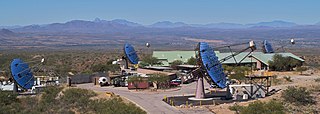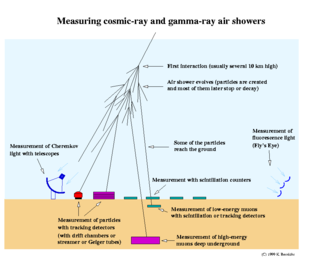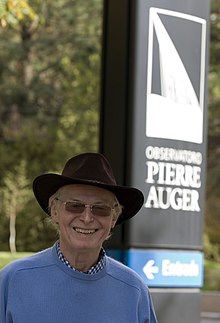
Cosmic rays are high-energy particles or clusters of particles that move through space at nearly the speed of light. They originate from the Sun, from outside of the Solar System in our own galaxy, and from distant galaxies. Upon impact with Earth's atmosphere, cosmic rays produce showers of secondary particles, some of which reach the surface, although the bulk is deflected off into space by the magnetosphere or the heliosphere.
The Greisen–Zatsepin–Kuzmin limit (GZK limit or GZK cutoff) is a theoretical upper limit on the energy of cosmic ray protons traveling from other galaxies through the intergalactic medium to our galaxy. The limit is 5×1019 eV (50 EeV), or about 8 joules (the energy of a proton travelling at ≈ 99.99999999999999999998% the speed of light). The limit is set by the slowing effect of interactions of the protons with the microwave background radiation over long distances (≈ 160 million light-years). The limit is at the same order of magnitude as the upper limit for energy at which cosmic rays have experimentally been detected, although indeed some detections appear to have exceeded the limit, as noted below. For example, one extreme-energy cosmic ray, the Oh-My-God Particle, which has been found to possess a record-breaking 3.12×1020 eV (50 joules) of energy (about the same as the kinetic energy of a 95 km/h baseball).

James Watson Cronin was an American particle physicist.
In astroparticle physics, an ultra-high-energy cosmic ray (UHECR) is a cosmic ray with an energy greater than 1 EeV (1018 electronvolts, approximately 0.16 joules), far beyond both the rest mass and energies typical of other cosmic ray particles.

Sir Arnold Whittaker Wolfendale FRS was a British astronomer who served as the fourteenth Astronomer Royal from 1991 to 1995. He was Professor of Physics at Durham University from 1965 until 1992 and served as president of the European Physical Society (1999–2001). He was President of the Royal Astronomical Society from 1981 to 1983.
Dr. Reuven Ramaty (1937—2001) was a Hungarian astrophysicist who worked for 30 years at NASA's NASA Goddard Space Flight Centre. He was a leader in the fields of solar physics, gamma-ray line spectrometry, nuclear astrophysics, and low-energy cosmic rays. Ramaty was a founding member of NASA's High Energy Solar Spectroscopic Imager which has now been renamed the Reuven Ramaty High Energy Solar Spectroscopic Imager in his honour. This was the first space mission to be named after a NASA scientist and was operational from 2002 until 2018. The Online Archive of California holds over 400 entries for documents, papers and photographs published by and of Ramaty and his work. Ramaty made many contributions in the field of astrophysics and solar physics. He was given the Goddard Lindsay Award in 1980 and had a tribute dedicated to his work at the University of Maryland in 2000.

Pierre Victor Auger was a French physicist, born in Paris. He worked in the fields of atomic physics, nuclear physics, and cosmic ray physics. He is famous for being one of the discoverers of the Auger effect, named after him.

An air shower is an extensive cascade of ionized particles and electromagnetic radiation produced in the atmosphere when a primary cosmic ray enters the atmosphere. When a particle, which could be a proton, a nucleus, an electron, a photon, or (rarely) a positron, strikes an atom's nucleus in the air it produces many energetic hadrons. The unstable hadrons decay in the air speedily into other particles and electromagnetic radiation, which are part of the particle shower components. The secondary radiation rains down, including x-rays, muons, protons, antiprotons, alpha particles, pions, electrons, positrons, and neutrons.

The Pierre Auger Observatory is an international cosmic ray observatory in Argentina designed to detect ultra-high-energy cosmic rays: sub-atomic particles traveling nearly at the speed of light and each with energies beyond 1018 eV. In Earth's atmosphere such particles interact with air nuclei and produce various other particles. These effect particles (called an "air shower") can be detected and measured. But since these high energy particles have an estimated arrival rate of just 1 per km2 per century, the Auger Observatory has created a detection area of 3,000 km2 (1,200 sq mi)—the size of Rhode Island, or Luxembourg—in order to record a large number of these events. It is located in the western Mendoza Province, Argentina, near the Andes.
The Akeno Giant Air Shower Array (AGASA) is a very large surface array designed to study the origin of ultra-high-energy cosmic rays. Located in the town of Akeno in Yamanashi prefecture, Japan, it covers an area of 100 km2 and consists of 111 surface detectors and 27 muon detectors. Array experiments such as this one are used to detect air shower particles.

VERITAS is a major ground-based gamma-ray observatory with an array of four 12 meter optical reflectors for gamma-ray astronomy in the GeV – TeV photon energy range. VERITAS uses the Imaging Atmospheric Cherenkov Telescope technique to observe gamma rays that cause particle showers in Earth's atmosphere that are known as extensive air showers. The VERITAS array is located at the Fred Lawrence Whipple Observatory, in southern Arizona, United States. The VERITAS reflector design is similar to the earlier Whipple 10-meter gamma-ray telescope, located at the same site, but is larger in size and has a longer focal length for better control of optical aberrations. VERITAS consists of an array of imaging telescopes deployed to view atmospheric Cherenkov showers from multiple locations to give the highest sensitivity in the 100 GeV – 10 TeV band. This very high energy observatory, completed in 2007, effectively complements the Large Area Telescope (LAT) of the Fermi Gamma-ray Space Telescope due to its larger collection area as well as coverage in a higher energy band.
Astroparticle physics, also called particle astrophysics, is a branch of particle physics that studies elementary particles of astronomical origin and their relation to astrophysics and cosmology. It is a relatively new field of research emerging at the intersection of particle physics, astronomy, astrophysics, detector physics, relativity, solid state physics, and cosmology. Partly motivated by the discovery of neutrino oscillation, the field has undergone rapid development, both theoretically and experimentally, since the early 2000s.

The Michael Faraday Medal and Prize is a gold medal awarded annually by the Institute of Physics in experimental physics. The award is made "for outstanding and sustained contributions to experimental physics." The medal is accompanied by a prize of £1000 and a certificate.

Extragalactic cosmic rays are very-high-energy particles that flow into the Solar System from beyond the Milky Way galaxy. While at low energies, the majority of cosmic rays originate within the Galaxy (such as from supernova remnants), at high energies the cosmic ray spectrum is dominated by these extragalactic cosmic rays. The exact energy at which the transition from galactic to extragalactic cosmic rays occurs is not clear, but it is in the range 1017 to 1018 eV.

A cosmic-ray observatory is a scientific installation built to detect high-energy-particles coming from space called cosmic rays. This typically includes photons, electrons, protons, and some heavier nuclei, as well as antimatter particles. About 90% of cosmic rays are protons, 9% are alpha particles, and the remaining ~1% are other particles.

The High Altitude Water Cherenkov Experiment or High Altitude Water Cherenkov Observatory is a gamma-ray and cosmic ray observatory located on the flanks of the Sierra Negra volcano in the Mexican state of Puebla at an altitude of 4100 meters, at 18°59′41″N97°18′30.6″W. HAWC is the successor to the Milagro gamma-ray observatory in New Mexico, which was also a gamma-ray observatory based around the principle of detecting gamma-rays indirectly using the water Cherenkov method.
Multi-messenger astronomy is astronomy based on the coordinated observation and interpretation of disparate "messenger" signals. Interplanetary probes can visit objects within the Solar System, but beyond that, information must rely on "extrasolar messengers". The four extrasolar messengers are electromagnetic radiation, gravitational waves, neutrinos, and cosmic rays. They are created by different astrophysical processes, and thus reveal different information about their sources.

The College of Science at the University of Utah is an academic college of the University of Utah in Salt Lake City, Utah. The college offers undergraduate and graduate degrees in atmospheric science, biology, chemistry, geology and geophysics, mathematics, metallurgical engineering, mining engineering and physics and astronomy.

Angela Villela Olinto is an astroparticle physicist and the Albert A. Michelson Distinguished Service Professor at the University of Chicago as well as the Dean of the Physical Sciences Division. Her current work is focused on understanding the origin of high-energy cosmic rays, gamma rays, and neutrinos.
Francis Louis Halzen is a Belgian particle physicist. He is the Hilldale and Gregory Breit Distinguished Professor at the University of Wisconsin–Madison and Director of its Institute for Elementary Particle Physics. Halzen is the Principal Investigator of the IceCube Neutrino Observatory at the Amundsen–Scott South Pole Station in Antarctica, the world's largest neutrino detector which has been operational since 2010.












